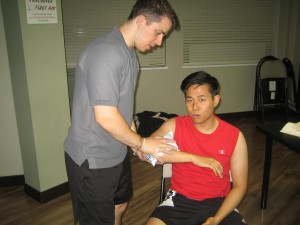Thrower’s elbow or medial epicondylitis involves inflammation of the medial epicondyle of the elbow which is strikingly parallel to tennis elbow. Thrower’s elbow develops when there is damage to the muscles, bones, tendons and ligaments around the joint of the elbow and the forearm. The throwing movement will cause the structures on the medial side or the inside part of the elbow to stretch and also compresses the structure on the lateral side or the outside of the elbow. The constant stretching on the medial side can cause severe strain on the ligament. This condition is an overuse injury such as repetitive throwing motions which leads to inflammation of the forearm muscles.
[youtube url=”https://www.youtube.com/watch?v=TzXu5dcbSoc”]
Causes of thrower’s elbow
- Overuse of the affected area
- Repetitive and prolonged straining of the forearm muscles and not getting adequate rest.
- A direct injury such as a fall or bump into the elbow
- Using ill-fitting equipment such as golf clubs, work tools and tennis racquets
- Poor general fitness and conditioning of the body.
The most common symptom of thrower’s elbow is pain that can be felt on both sides of elbow joint.
Symptoms of thrower’s elbow
- The most common symptom of thrower’s elbow is pain that can be felt on both sides of elbow joint.
- Pain can also be experienced in any area from the joint of the elbow up to the wrist.
- There is stiffness, weakness and restricted movement among people suffering from thrower’s elbow
- Tingling and numbness
- There is pain with pronation of the wrist against resistance
Treatment
- Take plenty of rest especially the affected elbow to promote fast healing of the area.
- Apply an ice pack on the affected area for at least 15-20 minutes to lessen the pain and swelling for the first 48-72 hours.
- Wear a compression bandage to minimize swelling of the area.
- Wear a brace to lessen pressure on the joint and for fast healing of the affected area.
- Elevate the affected area above the level of the heart.
- Apply heat on the affected area and massage the area to help with the removal of scar tissue and for rapid healing of the tendons and muscles
- When pain is minimized, improve the strength, endurance, power and flexibility of the tendons and muscles.
- Take the prescribed anti-inflammatory medications such as ibuprofen and naproxen to lessen the pain and inflammation.
Tips
- Perform thorough and correct warm up to prepare the tendons and muscles for any activity. Lack of proper warm-up can cause the tendons and muscles to stiffen and tighten. This results to lessened flow of blood in the area and reduces the amount of oxygen and nutrients needed by the muscles.
- It is important that muscles and tendons should be flexible to prevent strain and sprain When the muscles and tendons are flexible, they can move and perform activities without being overstretched. If the muscle and tendons are stiff and tight, they have limited range of motion.
- Strengthen and condition the muscles of the wrist and forearm to prevent the condition from developing.

